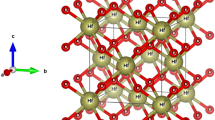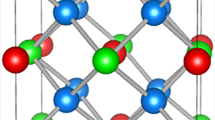Abstract
The work interprets experimental data for the heat capacity of Zn2(BDC)2(DABCO) in the region of second-order phase transitions. The proposed understanding of the processes occurring during phase transitions may be helpful to reveal quantum Zeno effects in metal–organic frameworks (MOFs) with evolving (unstable) structural subsystems and to establish relations between quantum measurements and the entropy of phase transitions.


Similar content being viewed by others
References
Teuscher, C. (ed.): Alan Turing: Life and Legacy of a Great Thinker. Springer, Berlin (2004)
Khalfin, L.A.: Zeno’s quantum effect. Sov. Phys. Usp. 33, 868 (1990). https://doi.org/10.1070/PU1990v033n10ABEH002639
Misra, B., Suddarshan, E.C.G.: The Zeno’s paradox in quantum theory. J. Math. Phys. 18, 756 (1977). https://doi.org/10.1063/1.523304
Itano, W.M., Heinzen, D.J., Bollinger, J.J., Wineland, D.J.: Quantum zeno effect. Phys. Rev. A 41, 2295 (1990). https://doi.org/10.1103/PhysRevA.41.2295
Nakazato, H., Namiki, M., Pasazio, S., Rauch, H.: Understanding the quantum zeno effect. Phys. Lett. A 217, 203 (1996). https://doi.org/10.1016/0375-9601(96)00350-7
Home, D., Whitaker, M.A.B.: A conceptual analysis of quantum zeno; paradox, measurement, and experiment. Ann. Phys. (N.Y.) 258, 237 (1997). https://doi.org/10.1006/aphy.1997.5699
Koshino, K., Shimizu, A.: Quantum zeno effect for exponentially decaying systems. Phys. Rev. Lett. 92, 030401 (2004). https://doi.org/10.1103/PhysRevLett.92.03040
Nagels, B., Hermans, L.J.F., Chapovsky, P.L.: Quantum zeno effect Induced by collisions. Phys. Rev. Lett. 79, 3097 (1997). https://doi.org/10.1103/PhysRevLett.79.3097
Balzer, C., Huesmann, R., Neuhauser, W., Toschek, P.E.: The quantum zeno effect—evolution of an atom impeded by measurement. Opt. Commun. 180, 115 (2000). https://doi.org/10.1016/S0030-4018(00)00716-1
Patil, Y.S., Chakram, S., Vengalattore, M.: Measurement-induced localization of an ultracold lattice gas. Phys. Rev. Lett. 115, 140402 (2015). https://doi.org/10.1103/PhysRevLett.115.140402
Streed, E.W., Mun, J., Boyd, M., Campbell, G.K., Medley, P., Ketterle, W., Pritchard, D.E.: Continuous and pulsed quantum zeno effect. Phys. Rev. Lett. 97, 260402 (2006). https://doi.org/10.1103/PhysRevLett.97.260402
Huang, Y.P., Moore, M.G.: Interaction- and measurement-free quantum zeno gates for universal computation with single-atom and single-photon qubits. Phys. Rev. A 77, 062332 (2008). https://doi.org/10.1103/PhysRevA.77.062332
Franson, J.D., Jacobs, B.C., Pittman, T.B.: Quantum computing using single photons and the Zeno effect. Phys. Rev. A 70, 062302 (2004). https://doi.org/10.1103/PhysRevA.70.062302
Maniscalco, S., Francica, F., Zaffino, R.L., Gullo, N.L., Plastina, F.: Protecting entanglement via the quantum zeno effect. Phys. Rev. Lett. 100, 090503 (2008). https://doi.org/10.1103/PhysRevLett.100.090503
Cao, Y., Li, Y.-H., Cao, Z., Yin, J., Chen, Y.-A., Yin, H.-L., Chen, T.-Y., Ma, X., Peng, C.-Z., Pan, J.-W.: Direct counterfactual communication via quantum zeno effect. Proc. Natl. Acad. Sci. USA 114, 4920 (2017). https://doi.org/10.1073/pnas.1614560114
Hosten, O., Rakher, M., Barreiro, J., Peters, N.A., Kwiat, P.G.: Counterfactual quantum computation through quantum interrogation. Nature (London) 439, 949 (2006). https://doi.org/10.1038/nature04523
Kaulakys, B., Gontis, V.: Quantum anti-Zeno effect. Phys. Rev. A 56, 1131 (1997). https://doi.org/10.1103/PhysRevA.56.1131
Kofman, A.G., Kurizki, G.: Acceleration of quantum decay processes by frequent observations. Nature (London) 405, 546 (2000). https://doi.org/10.1038/35014537
Zhang, J.-M., Jing, J., Wang, L.-G., Zhu, S.-Y.: Criterion for quantum zeno and anti-zeno effects. Phys. Rev. A 98, 012135 (2018). https://doi.org/10.1103/PhysRevA.98.012135
Chen, P.-W., Tsai, D.-B., Bennett, P.: Quantum zeno and anti-zeno effect of a nanomechanical resonator measured by a point contact. Phys. Rev. B 81, 115307 (2010). https://doi.org/10.1103/PhysRevB.81.115307
Barone, A., Kurizki, G., Kofman, A.G.: Dynamical control of macroscopic quantum tunneling. Phys. Rev. Lett. 92, 200403 (2004). https://doi.org/10.1103/PhysRevLett.92.200403
Fujii, K., Yamamoto, K.: Anti-Zeno effect for quantum transport in disordered systems. Phys. Rev. A 82, 042109 (2010). https://doi.org/10.1103/PhysRevA.82.042109
Fischer, M.C., Gutiйrrez-Medina, B., Raizen, M.G.: Observation of the quantum zeno and anti-zeno effects in an unstable system. Phys. Rev. Lett. 87, 040402 (2001). https://doi.org/10.1103/PhysRevLett.87.040402
Maniscalco, S., Piilo, J., Suominen, K.-A.: Zeno and anti-zeno effects for quantum brownian motion. Phys. Rev. Lett. 97, 130402 (2006). https://doi.org/10.1103/PhysRevLett.97.130402
Chaudhry, A.Z.: A general framework for the quantum zeno and anti-zeno effects. Sci. Rep. 6, 29497 (2016). https://doi.org/10.1038/srep29497
Chaudhry, A.Z.: The quantum zeno and anti-zeno effects with strong system-environment coupling. Sci. Rep. 7, 1741 (2017). https://doi.org/10.1038/s41598-017-01844-8
He, S., Chen, Q.-H., Zheng, H.: Zeno and anti-zeno effect in an open quantum system in the ultrastrong-coupling regime. Phys. Rev. A 95, 062109 (2017). https://doi.org/10.1103/PhysRevA.95.062109
Zhou, Z., Lu, Z., Zheng, H., Goan, H.S.: Quantum zeno and anti-zeno effects in open quantum systems. Phys. Rev. A 96, 032101 (2017). https://doi.org/10.1103/PhysRevA.96.032101
Zhang, Y.-R., Fan, H.: Zeno dynamics in quantum open systems. Sci. Rep. 5, 11509 (2015). https://doi.org/10.1038/srep11509
Facchi, P., Nakazato, H., Pascazio, S.: From the quantum zeno to the inverse quantum zeno effect. Phys. Rev. Lett. 86, 2699 (2001). https://doi.org/10.1103/PhysRevLett.86.2699
Koshino, K., Shimizu, A.: Quantum zeno effect by general measurements. Phys. Rep. 412, 191 (2005). https://doi.org/10.1016/j.physrep.2005.03.001
Facchi, P., Pascazio, S.: Quantum zeno dynamics: mathematical and physical aspects. J. Phys. A 41, 493001 (2008). https://doi.org/10.1088/1751-8113/41/49/493001
Wuster, S.: Quantum zeno suppression of intramolecular forces. Phys. Rev. Lett. 119, 013001 (2017). https://doi.org/10.1103/PhysRevLett.119.013001
Rebentrost, P., Mohseni, M., Kassal, I., Lloyd, S., Aspuru-Guzik, A.: Environment-assisted quantum transport. New J. Phys. 11, 033003 (2009). https://doi.org/10.1088/1367-2630/11/3/033003
Erez, N., Gordon, G., Nest, M., Kurizki, G.: Thermodynamic control by frequent quantum measurements. Nature (London). 452, 724 (2008). https://doi.org/10.1038/nature06873
Zheng, H., Zhu, S.Y., Zubairy, M.S.: Quantum zeno and anti-zeno effects: without the rotating-wave approximation. Phys. Rev. Lett. 101, 200404 (2008). https://doi.org/10.1103/PhysRevLett.101.200404
Wang, D.-W., Wang, L.-G., Li, Z.-H., Zhu, S.Y.: Anti-Zeno-effect recovery and Lamb-shift modification in modified vacuum. Phys. Rev. A 80, 042101 (2009). https://doi.org/10.1103/PhysRevA.80.042101
Li, Z.-H., Wang, D.-W., Zheng, H., Zhu, S.-Y., Zubairy, M.S.: Effect of the counterrotating-wave terms on the spontaneous emission from a multilevel atom. Phys. Rev. A 80, 023801 (2009). https://doi.org/10.1103/PhysRevA.80.023801
Cao, X., You, J.Q., Zheng, H., Kofman, A.G., Franco, N.: Dynamics and quantum zeno effect for a qubit in either a low- or high-frequency bath beyond the rotating-wave approximation. Phys. Rev. A 82, 022119 (2010). https://doi.org/10.1103/PhysRevA.82.022119
Ai, Q., Li, Y., Zheng, H., Sun, C.P.: Quantum anti-zeno effect without rotating wave approximation. Phys. Rev. A 81, 042116 (2010). https://doi.org/10.1103/PhysRevA.81.042116
Bosco de Magalhгes, A.R., Rossi, R., Nemes, M.C.: Environment induced quantum zeno effect in coupled microwave cavities. Phys. Lett. A 375, 1724 (2011). https://doi.org/10.1016/j.physleta.2011.03.017
Harris, R.A., Stodolsky, L.: On the time dependence of optical activity. J. Chem. Phys. 74, 2145 (1981). https://doi.org/10.1063/1.441373
Harris, R.A., Stodolsky, L.: Two state systems in media and “Turing’s paradox.” Phys. Lett. B 116, 464 (1982). https://doi.org/10.1016/0370-2693(82)90169-1
Bernu, J.: Freezing coherent field growth in a cavity by the quantum zeno effect. Phys. Rev. Lett. 101, 180402 (2008). https://doi.org/10.1103/PhysRevLett.101.180402
Oliveira, L.F.L., Rossi, R., de Magalhães, A.R.B., de Faria, J.G.P., Nemes, M.C.: Continuous monitoring of dynamical systems and master equations. Phys. Lett. A 376, 1786 (2012). https://doi.org/10.1016/j.physleta.2012.04.017
Gordon, G., Erez, N., Kurizki, G.: Control of temperature and entropy by frequent quantum measurements. Optic Spectrosc. 108, 400 (2010). https://doi.org/10.1134/S0030400X10030136
Chaudhry, A.Z., Gong, J.: Zeno and anti-zeno effects on dephasing. Phys. Rev. A 90, 012101 (2014). https://doi.org/10.1103/PhysRevA.90.012101
Gelbwaser-Klimovsky, D., Niedenzu, W., Kurizki, G.: Chapter Twelve - Thermodynamics of Quantum Systems Under Dynamical Control. In: Arimondo, E., Lin, C., Yelin, S. (eds.) Advances in Atomic, Molecular, and Optical Physics, vol. 64. Elsevier Inc (2015). https://doi.org/10.1016/bs.aamop.2015.07.002
Dybtsev, D.N., Chun, H., Kim, K.: Rigid and flexible: a highly porous metal–organic framework with unusual guest-dependent dynamic behavior. Angew. Chem. Int. Ed. 43, 5033 (2004). https://doi.org/10.1002/anie.200460712
Kim, Y., Haldar, R., Kim, H., Koo, J., Kim, K.: The guest-dependent thermal response of the flexible MOF Zn2(BDC)2(DABCO). Dalton Trans. 45, 4187 (2016). https://doi.org/10.1039/C5DT03710G
Gabuda, S.P., Kozlova, S.G., Samsonenko, D.P., Dybtsev, D.N., Fedin, V.P.: Quantum rotations and chiral polarization of qubit prototype molecules in a highly porous metal–organic framework: 1H NMR T1 study. J. Phys. Chem. C 115, 20460 (2011). https://doi.org/10.1021/jp206725k
Sabylinskii, A.V., Gabuda, S.P., Kozlova, S.G., Dybtsev, D.N., Fedin, V.P.: 1NMR refinement of the structure of the guest sublattice and molecular dynamics in the ultrathin channels of [Zn2(C8H4O4)2(C6H12N2)]n(H3C)2NCHO”. J. Struct. Chem. 50, 421 (2009). https://doi.org/10.1007/s10947-009-0063-6
Khudozhitkov, A.E., Kolokolov, D.I., Stepanov, A.G., Bolotov, V.A., Dybtsev, D.N.: Metal-cation-independent dynamics of phenylene ring in microporous MOFs: a 2H solid-state NMR study. J. Phys. Chem. C 119, 28038 (2015). https://doi.org/10.1021/acs.jpcc.5b09435
Paukov, I.E., Samsonenko, D.P., Pishchur, D.P., Kozlova, S.G., Gabuda, S.P.: Phase transitions and unusual behavior of heat capacity in metal organic framework compound Zn2(C8H4O4)2 N2(CH2)6. J. Solid State Chem. 220, 254 (2014). https://doi.org/10.1016/j.jssc.2014.09.007
Pishchur, D.P., Kompankov, N.B., Lysova, A.A., Kozlova, S.G.: Order-disorder phase transitions in Zn2(C8H4O4)2C6H12N2 in atmospheres of noble gases. J. Chem. Thermodyn. 130, 147 (2019). https://doi.org/10.1016/j.jct.2018.10.004
Gabuda, S.P., Kozlova, S.G.: Chirality-related interactions and a mirror symmetry violation in handed nano structures. J. Chem. Phys. 141, 044701 (2014). https://doi.org/10.1063/1.4890327
Gabuda, S.P., Kozlova, S.G.: Abnormal difference between the mobilities of left- and right-twisted conformations of C6H12N2 roto-symmetrical molecules at very low temperatures. J. Chem. Phys. 142, 234302 (2015). https://doi.org/10.1063/1.4922542
Kozlova, S.G., Mirzaeva, I.V., Ryzhikov, M.R.: DABCO molecule in the M2(C8H4O4)2C6H12N2 (M = Co, Ni, Cu, Zn) metal-organic frameworks. Coord. Chem. Rev. 376, 62 (2018). https://doi.org/10.1016/j.ccr.2018.07.008
Kozlova, S.G., Gabuda, S.P.: Thermal properties of Zn2(C8H4O4)2•C6H12N2 metal-organic framework compound and mirror symmetry violation of dabco molecules. Sci. Rep. 7, 11505 (2017). https://doi.org/10.1038/s41598-017-11326-6
Kozlova, S.G.: Behavior of the heat capacity at second-order phase transitionsin the [Zn2(C8H4O4)2·C6H12N2] metal-organic framework compound. JETP Lett. 104, 253 (2016). https://doi.org/10.1134/S0021364016160074
Kozlova, S., Ryzhikov, M., Pishchur, D., Mirzaeva, I.: Overview of low-temperature heat capacity data for Zn2(C8H4O4)2C6H12N2 and the salam hypothesis. Symmetry 11, 657 (2019). https://doi.org/10.3390/sym11050657
Nizovtsev, A.S., Ryzhikov, M.R., Kozlova, S.G.: Structural flexibility of DABCO. Ab initio and DFT benchmark study. Chem. Phys. Lett. 667, 87 (2017). https://doi.org/10.1016/j.cplett.2016.11.042
Mathivon, K., Linguerri, R., Hochlaf, M.: Systematic theoretical studies of the interaction of 1,4-diazabicyclo[2.2.2]octane (DABCO) with rare gases. J. Chem. Phys. 139, 164306 (2013). https://doi.org/10.1063/1.4826449
Hoffmann, H.C., Assfour, B., Epperlein, F., Klein, N., Paasch, S., Senkovska, I., Kaskel, S., Seifert, G., Brunner, E.: High-pressure in situ 129Xe NMR spectroscopy and computer simulations of breathing transitions in the metal organic framework Ni2(2,6-ndc)2(dabco) (DUT-8(Ni)). J. Am. Chem. Soc. 133, 8681 (2011). https://doi.org/10.1021/ja201951t
Glyde, H.R., Svensson, E.C.: Solid and liquid helium. Methods Exp. Phys. 23, 303 (1987). https://doi.org/10.1016/S0076-695X(08)60573-6
Zuluaga, S., Canepa, P., Tan, K., Chaba, Y.J., Thonhauser, T.: Study of van der Waals bonding and interactions in metal organic framework materials. J. Phys. 26, 133002 (2014). https://doi.org/10.1088/0953-8984/26/13/133002
Ryzhikov, M.R., Kozlova, S.G.: Interactions between building blocks of the Zn2(BDC)2DABCO metal-organic framework. J. Struct. Chem. 61, 161 (2020). https://doi.org/10.1134/S0022476620020018
Ryzhikov, M.R., Kozlova, S.G.: Understanding structural flexibility of the paddle-wheel Zn-SBU motif in MOFs: influence of pillar ligands. Phys. Chem. Chem. Phys. 21, 11977 (2019). https://doi.org/10.1039/c9cp02483b
Funding
Not applicable.
Author information
Authors and Affiliations
Contributions
SGK, DPP have equal rights.
Corresponding author
Ethics declarations
Conflict of interest
All authors declare that they have no conflict of interest.
Additional information
Publisher's Note
Springer Nature remains neutral with regard to jurisdictional claims in published maps and institutional affiliations.
Rights and permissions
About this article
Cite this article
Kozlova, S.G., Pishchur, D.P. On the Possibility to Observe Relations Between Quantum Measurements and the Entropy of Phase Transitions in Zn2(BDC)2(DABCO). Found Phys 51, 8 (2021). https://doi.org/10.1007/s10701-021-00416-1
Received:
Accepted:
Published:
DOI: https://doi.org/10.1007/s10701-021-00416-1




